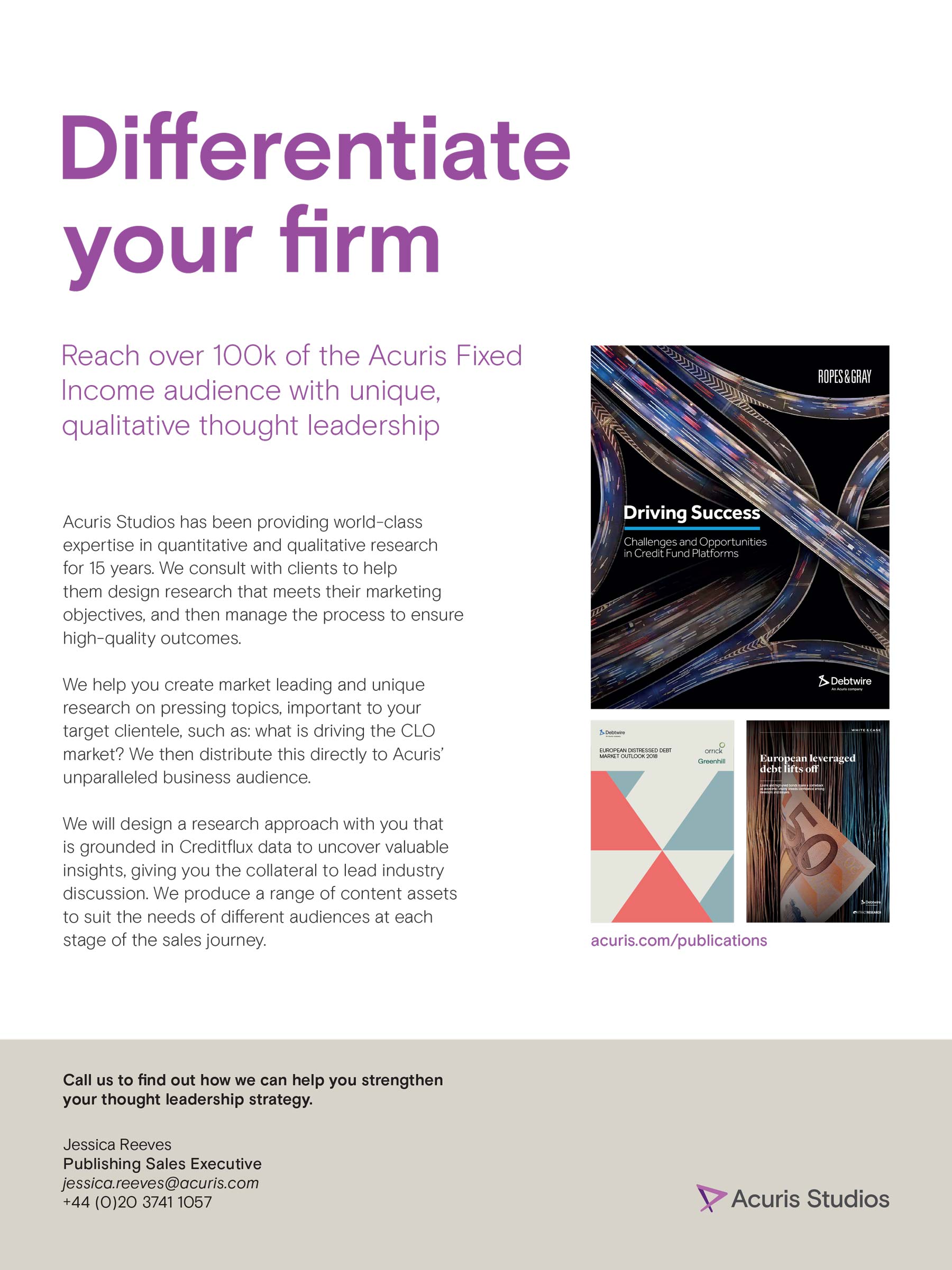

June 2021 | Issue 235
Opinion Multi-strategy credit
Don’t buy loans for the floating rate component alone

Matt Eagan
Portfolio manager and co-head of full discretion team
Loomis Sayles
Born:
Holliston, a small town 30 miles west of Boston
Lives:
South End, Boston
Education:
Business administration at Northeastern University, having started out on an engineering programme. MBA from Boston University.
Hidden talent:
Eagan and his wife are amateur artists. She has painted a series on central bankers, which includes one signed by Ben Bernanke.
Favourite movie:
Lord of the Rings, for sentimental reasons. This was a bedtime story and Eagan went to watch it with his dad.
Last holiday:
Florida was the first post-Covid break.
Bucket list:
To travel to Latin America, specifically Buenos Aires.
Career:
Eagan joined Loomis Sayles in 1997, having started his career as an analyst at BancBoston Financial company and then Liberty Mutual. Since 2000 he has served as a portfolio manager and his current role encompasses a range of credit strategies including investment grade, high yield loans, emerging markets and structured credit.Loomis Sayles:
was founded in 1926 and is an affiliate of Natixis Investment Management after an acquisition in 2000. It has $345.7 billion of assets under management with $166.6 billion in mutual funds. The full discretion team oversees about $30.5 billion in assets.Q.
What are the best and worst investments?
A. Most assets are fully priced and some are downright frothy. In fixed income, there’s very little upside relative to downside given the low starting yields and high dollar prices. One interesting area for this stage of the market is convertible bonds — it’s nice that your upside is not capped as the stock attaches at some point and you have the upside potential of the stock.
You can find opportunities in specific stories that are less dependent on macro trends and more dependent on what’s affecting a particular company. I would not say there is really cheap value right now, but you can find some names that have more upside and may be fairly priced.
The worst investments involve anything with a lot of duration tied to them, such as long-dated corporate bonds and treasuries — these and other assets that don’t have a lot of carry to absorb the rise we see coming in rates. But things have changed quickly. Last August a 30-year treasury would have looked like a tech stock from a total return standpoint. That has now flipped.
You can find opportunities in specific stories that are less dependent on macro trends and more dependent on what’s affecting a particular company. I would not say there is really cheap value right now, but you can find some names that have more upside and may be fairly priced.
The worst investments involve anything with a lot of duration tied to them, such as long-dated corporate bonds and treasuries — these and other assets that don’t have a lot of carry to absorb the rise we see coming in rates. But things have changed quickly. Last August a 30-year treasury would have looked like a tech stock from a total return standpoint. That has now flipped.
Q.
What about loans as a hedge against rising rates?A.
The caveat for bank loans is never buy a credit-related sector, particularly one down in quality, based on interest rates. There are three primary risks with bank loans: credit risk, credit risk and credit risk. If you’re wrong about the credit risk, rates could go higher and you will get crushed. Q.
What is the best trade you ever made?
A.
We do our best work in dislocations. A lot of what’s going on in equities right now is indicative of a bubble bursting without a lot of fanfare. It reminds me of the Nasdaq bubble — when it burst there were a lot of interesting companies trading cheaply.
One of them was Alcatel, which was once the R&D arm of the old AT&T monopoly. Our research showed its patents were extremely valuable, even though the business was levered and shrinking. We bought 30-year bonds at between 30 and 60 cents on the dollar, knowing the patents would cover us to par. They finally ended up being taken out at 131.
Q.
Where is the market heading?A.
We have come full cycle back to expansion, and the speed at which that has happened is not surprising. The US Fed has embraced the overshoot of inflation — although we don’t see it in wages — and that is starting to be understood now and has implications on the yield curve. Fiscal policy is far reaching and significant; it is tied to a paradigm political shift, which is a result of inequality and populism in the market.
Right now things are reasonably calm. Economic data will look better and better, but we are reaching peak liquidity and that’s what the market is feeling right now. Inflation uncertainty will cause risk premiums to rise and we could see bouts of illiquidity in the market, so investors need to leave space in portfolios to take advantage of opportunities. Rather than go short credit, I would rather have dry powder.
Q.
What needs to change about the way your industry does business?
A.
One of the challenges since 2008 is that, across the board, liquidity has been spotty. Early in my career you could trade $100 million on a name in the corporate market easily, but it is now difficult to trade big tickets. Banks are not putting as much capital towards this, but passive ETFs have opened up liquidity pools for the market. Asset managers and our clients need to play some of that role of continually evolving and innovating.
Global credit funds & CLO's
June 2021 | Issue 235
Published in London & New York.
Copyright Creditflux. All rights reserved. Check our Privacy Policy and our Terms of Use.


















